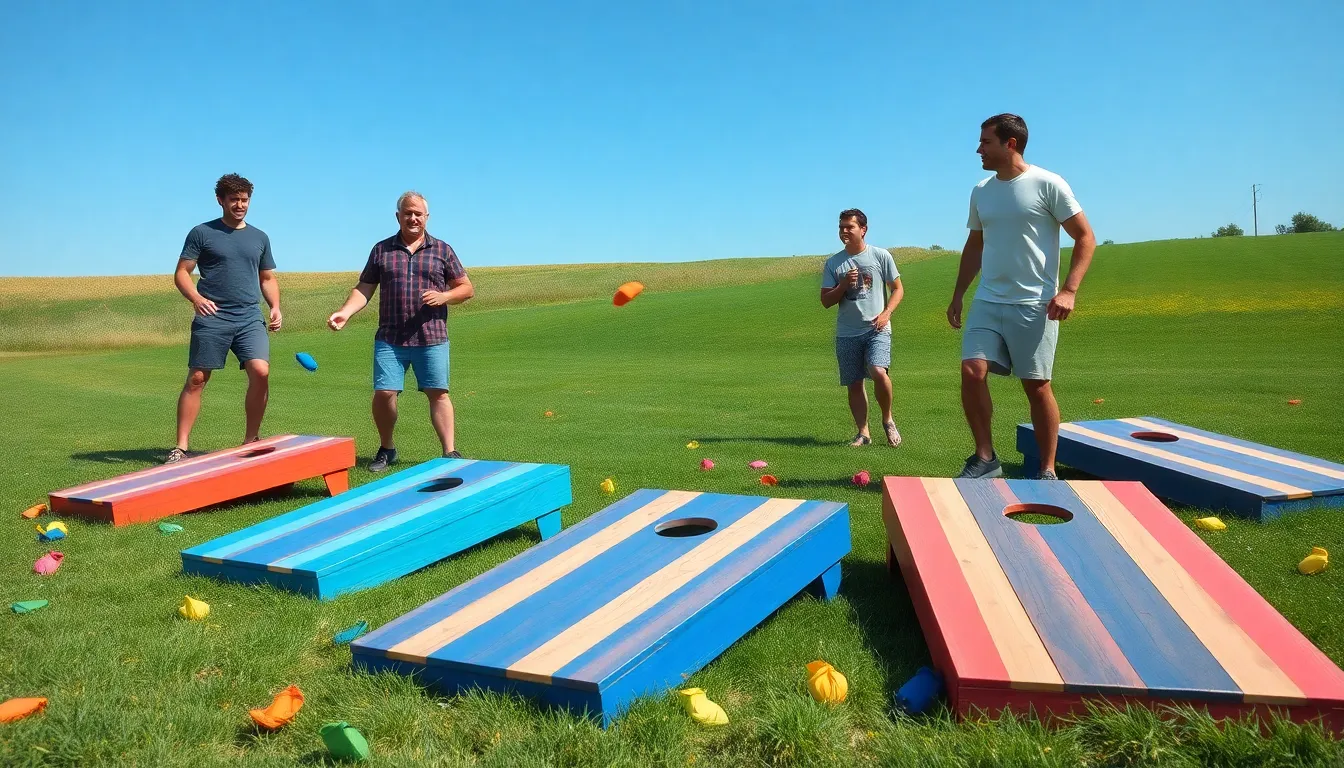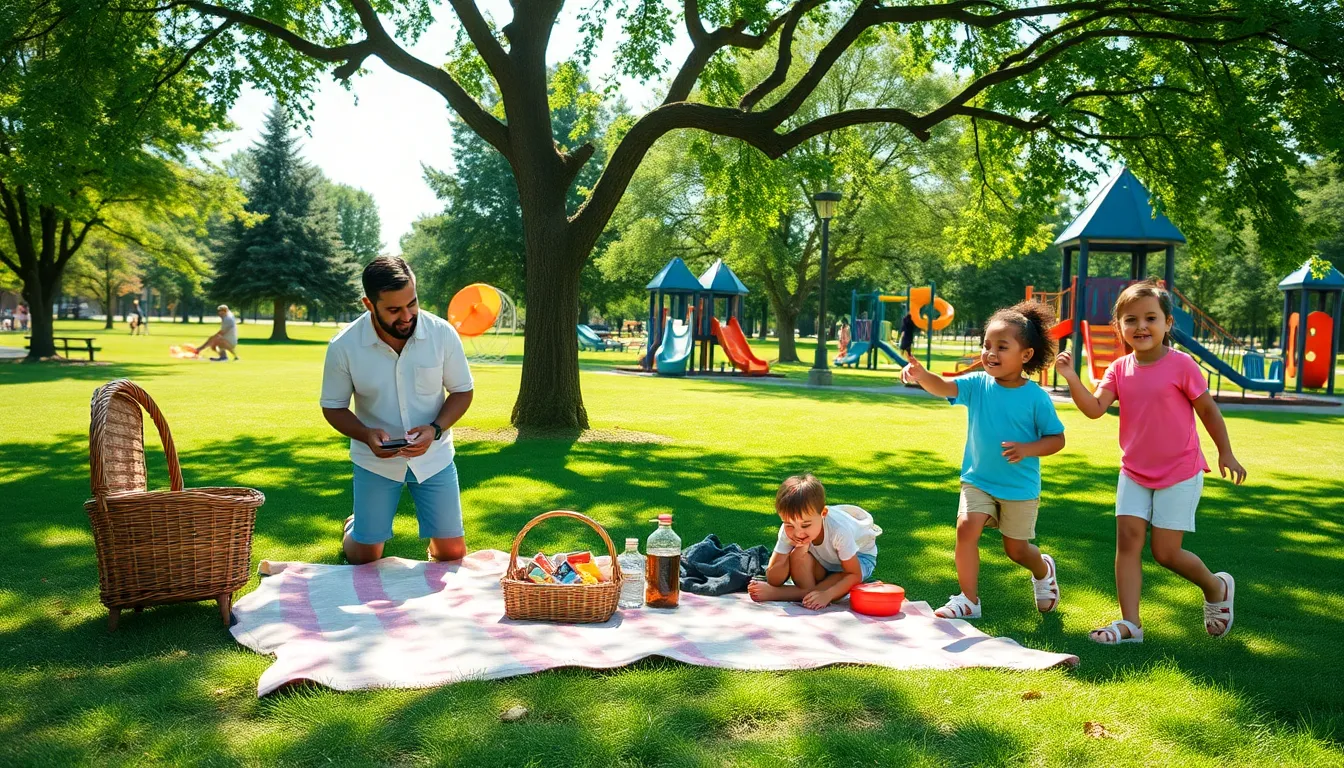Bean bag toss, also known as cornhole, isn’t just a game; it’s a rite of passage for backyard barbecues and tailgate parties. Picture this: friends gathered around, laughter echoing, and a fierce competition brewing over who can toss a bag into a hole from a distance. It’s the perfect blend of skill and luck, where even the most uncoordinated can shine—after all, who doesn’t love the sweet sound of a bean bag landing perfectly in the hole?
Table of Contents
ToggleOverview of Bean Bag Toss
Bean bag toss, widely recognized as cornhole, features two teams aiming to score points by tossing bags filled with corn or beans toward a raised platform. Each platform contains a hole that teams target during gameplay. Scoring occurs based on whether a bag lands on the platform or goes through the hole.
Players alternate turns, and each bag thrown contributes strategically to their total score. A bag landing on the board earns one point, while a bag that goes through the hole scores three points. Games are typically played until a team reaches 21 points, adding an element of strategy in choosing shots while maintaining a competitive atmosphere.
The simplicity of the rules makes it accessible for those of all skill levels. Bean bag toss encourages friendly competition, drawing participants from various backgrounds. Whether at a backyard barbecue or a large tournament, players enjoy bonding over their shared experiences and friendly rivalries.
Drain expectations unfold as players refine their tossing techniques. Developing skills like accuracy and consistency enhances their chances of winning. Casual players often enjoy the game for its social aspect, while serious competitors focus on improving their performance through practice and strategy.
While the game maintains origins in the Midwest, its popularity has spread nationwide, influencing a range of social settings. Competitive leagues and events now celebrate the sport, further solidifying its place in American culture. Bean bag toss not only provides entertainment but also fosters camaraderie among participants, making it a beloved choice for gatherings.
History of Bean Bag Toss
Bean bag toss, known widely as cornhole, boasts a rich history that traces its roots back to the Midwest. Games resembling bean bag toss appeared in the late 19th century, primarily within farmers’ markets and local festivals. Craftsmen initially designed the boards using wood and created bags filled with corn or beans. Over time, variations of the game emerged, reflecting regional preferences.
Origins and Evolution
The origins of bean bag toss date back to ancient cultures that used similar tossing games for recreation. One documented precursor is “faba,” a game played in ancient Greece, signifying that tossing games span centuries. The modern version gained traction in the 1970s, gaining popularity among children and adults during family gatherings and tailgate parties. By introducing formal rules and scoring methods, enthusiasts began organizing informal competitions. This evolution allowed players to refine techniques and strategies, solidifying the game’s status as both a leisure activity and a competitive sport.
Popularity in Different Regions
Popularity thrives across various regions in the United States. In the Midwest, especially in states like Ohio and Indiana, cornhole has become a staple at community events. Southern states have embraced the game as a central element of tailgating during college football season. Meanwhile, urban areas enjoy it in parks, breweries, and backyard gatherings, reflecting its versatility. This widespread appeal leads to numerous regional leagues and tournaments, showcasing players’ skills while promoting community engagement.
Rules and Gameplay
Bean bag toss, often called cornhole, follows a straightforward set of rules that enhance player engagement. Understanding the rules and gameplay structure allows participants to compete effectively and enjoy the experience.
Basic Rules
Teams consist of two players each, taking turns tossing bags. Each player throws four bags per round, aiming for the raised platform. Placement of the boards requires them to be 27 feet apart, and both boards should be angled with the hole positioned 9 inches from the top. Players alternate turns, allowing strategic play while maintaining a casual atmosphere. Winning occurs when a team reaches or surpasses 21 points, although some prefer varying the target score for a more extended game.
Scoring System
Scoring in bean bag toss is structured around bag placement. A bag landing on the platform earns one point, and a bag that goes through the hole nets three points. Points cancel against opponents’ bags; only higher-scoring bags count in each round. A round typically concludes after both teams finish throwing all bags. After calculating points, the game continues until one team achieves the agreed-upon score. Variations exist, so players often adjust rules to fit the occasion and their skill levels.
Equipment Overview
Bean bag toss requires specific equipment designed for optimal gameplay. Key components include bean bags and game boards, each serving a unique purpose in the game.
Types of Bean Bags
Bean bags come in various materials and sizes, influencing gameplay experience. Most bags contain corn, beans, or synthetic filling, providing different weights and feels. Standard regulations suggest a size of 6 inches by 6 inches, ensuring uniformity across games. Players might prefer different fabrics; duck cloth offers durability and a good grip, while canvas provides a softer touch. Choosing the right bag ensures consistency in tossing and can impact scoring.
Game Boards and Setups
Game boards are essential for bean bag toss and typically measure 24 inches by 48 inches. Boards should be made from plywood or similar materials for stability and durability. Proper setup involves placing boards 27 feet apart for standard competitions, while casual play may allow closer distances. Each board features a perfectly positioned hole, 9 inches from the top, which adds difficulty. Positioning and angling the boards can further enhance gameplay strategy and challenge players.
Benefits of Playing Bean Bag Toss
Playing bean bag toss offers numerous advantages. It enhances social interactions, bringing friends and family together for fun gatherings. Friendly competition arises during gameplay, fostering camaraderie among players.
The game promotes physical activity without intense exertion. Tossing bags strengthens upper body muscles and improves hand-eye coordination. Engaging in this activity provides light cardiovascular benefits while keeping players entertained.
It supports mental agility, requiring strategic thinking and focus to excel. Players analyze opponents’ moves and adapt their strategies accordingly. This mental engagement sharpens cognitive skills, making the game appealing for all ages.
Bean bag toss also nurtures inclusivity. Anyone, regardless of skill level, can join in and enjoy the experience. The accessibility of the game encourages participation from newcomers and seasoned players alike.
Flexible setups enhance its appeal, allowing play in various environments—backyards, parks, and tailgate events. The portability of equipment makes it easy to take along for gatherings and celebrations.
People often find joy in the relaxed atmosphere the game creates. Laughter and friendly banter add to the enjoyment, cultivating lasting memories. Bean bag toss remains a favorite choice for social occasions, reinforcing its cultural significance.
The benefits of playing bean bag toss extend beyond mere entertainment. The experience strengthens bonds, promotes fitness, and challenges the mind, making it a beloved pastime in various settings.
Tips for Improvement
Improving in bean bag toss involves mastering techniques and avoiding common mistakes.
Techniques and Strategies
Effective tossing techniques significantly enhance a player’s accuracy. Focus on grip; holding the bag firmly yet comfortably allows for smooth releases. Players should practice their stance, aligning their body with the target. Consistent foot placement adds stability during each throw. Aiming for a soft toss rather than a hard throw promotes better control and reduces the chance of bouncing off the board. Incorporating a follow-through motion assists in directing the bag toward the hole. Many players also benefit from anticipating opponents’ throws, adjusting their strategy based on the situation. Regular practice combined with analyzing opponents’ techniques can lead to noticeable improvements over time.
Common Mistakes to Avoid
Awareness of common mistakes can prevent unnecessary losses. A frequent error occurs when players disregard their stance, causing inconsistent throws. Overthrowing the bag often leads to missed targets and frustration. Many players neglect to consider wind conditions, which can affect bag trajectory. Failing to account for this can result in off-target throws. Additionally, some individuals rush their turns, leading to poor technique and missed opportunities. Keeping count and forgetting to keep score can complicate the game, leading to disputes. Staying focused and maintaining a relaxed demeanor contributes to better performance during play.
Conclusion
Bean bag toss continues to thrive as a cherished game that unites people across generations. Its combination of skill and luck makes it an exciting choice for gatherings of all kinds. Whether played casually at a barbecue or competitively in a tournament, the game fosters connections and creates lasting memories.
As players refine their techniques and adapt their strategies, they not only enhance their skills but also deepen their enjoyment of the game. With its rich history and inclusive nature, bean bag toss remains a beloved pastime that encourages friendly competition and camaraderie. It’s more than just a game; it’s a celebration of community and the joy of shared experiences.









